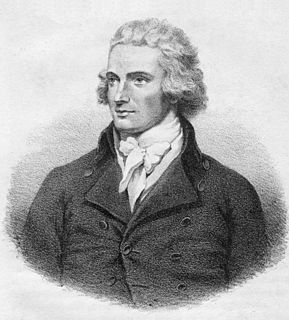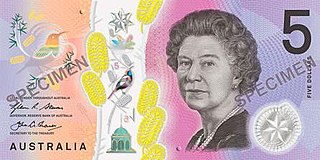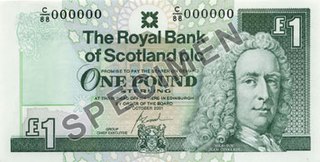Related Research Articles

Sir Walter Scott, 1st Baronet, was a Scottish historical novelist, poet, playwright and historian. Many of his works remain classics of European and Scottish literature, notably the novels Ivanhoe, Rob Roy, Waverley, Old Mortality, The Heart of Mid-Lothian and The Bride of Lammermoor, and the narrative poems The Lady of the Lake and Marmion. He had a major impact on European and American literature.
The Australian dollar is the currency of Australia, including its external territories: Christmas Island, Cocos (Keeling) Islands, and Norfolk Island. It is officially used as currency by three independent Pacific Island states: Kiribati, Nauru, and Tuvalu. It is legal tender in Australia. Within Australia, it is almost always abbreviated with the dollar sign ($), with A$ or AU$ sometimes used to distinguish it from other dollar-denominated currencies. The $ symbol precedes the amount. It is subdivided into 100 cents.

Mungo Park was a Scottish explorer of West Africa. After an exploration of the upper Niger River around 1796, he wrote a popular and influential travel book titled Travels in the Interior Districts of Africa in which he theorized the Niger and Congo merged to become the same river. He was killed during a second expedition, having successfully traveled about two-thirds of the way down the Niger. With Park's death, the idea of a Niger-Congo merger remained an open question although it became the leading theory among geographers. The mystery of the Niger's course, which had been speculated about since the Ancient Greeks and was second only to the mystery of the Nile's source, was not solved for another 25 years, in 1830, when it was discovered the Niger and Congo were in fact separate rivers.
The dollar has been the currency of The Bahamas since 1966. It is normally abbreviated with the dollar sign $, or alternatively B$ to distinguish it from other dollar-denominated currencies. It is divided into 100 cents.

Sterling banknotes are the banknotes in circulation in the United Kingdom and its related territories, denominated in pounds sterling.

The Bank of Scotland plc is a commercial and clearing bank based in Scotland and is part of the Lloyds Banking Group, following the Bank of Scotland's implosion in 2008.

The Mauritian rupee is the currency of Mauritius. One rupee is subdivided into 100 cents. Several other currencies are also called rupee.

The Australian five-dollar note was first issued on 29 May 1967, fifteen months after the currency was changed from the pound to the dollar on 14 February 1966. It was a new denomination with mauve colouration – the pre-decimal system had no denomination with a value of £2+1/2. The first polymer version of the note was introduced in 1992. A major design update was issued from 1 September 2016, with a minor update to the signatures in 2019.
Banknotes of Scotland are the banknotes of the pound sterling that are issued by three Scottish retail banks and in circulation in Scotland. The issuing of banknotes by retail banks in Scotland is subject to the Banking Act 2009, which repealed all earlier legislation under which banknote issuance was regulated, and the Scottish and Northern Ireland Banknote Regulations 2009. Currently, three retail banks are allowed to print notes for circulation in Scotland: Bank of Scotland, Royal Bank of Scotland, and Clydesdale Bank.
New Zealand dollar banknotes are the banknotes in circulation in New Zealand, the Cook Islands, Tokelau, Niue and the Pitcairn Islands, denominated in the New Zealand dollar. They are issued by the Reserve Bank of New Zealand and since 1999 have been made of polymer.

Banknotes of the euro, the currency of the euro area and institutions, have been in circulation since the first series was issued in 2002. They are issued by the national central banks of the Eurosystem or the European Central Bank. In 1999 the euro was introduced virtually, and in 2002 notes and coins began to circulate. The euro rapidly took over from the former national currencies and slowly expanded around the European Union.

The ten euro note (€10) is the second-lowest value euro banknote and has been used since the introduction of the euro in 2002. The note is used in the 23 countries which have it as their sole currency ; with a population of about 343 million. In March 2022, there were approximately 2,837,000,000 ten euro banknotes in circulation around the eurozone. It is the fourth most widely circulated denomination, accounting for 10.2% of the total banknotes. Estimates suggest that the average life of a ten euro banknote is about 1.5 years before it is replaced due to wear.

The fifty euro note (€50) is one of the middle value euro banknotes and has been used since the introduction of the euro in 2002. The note is used by some 343 million Europeans and in the 23 countries which have the euro as their sole currency. In March 2022, there were about 13,819,000,000 fifty euro banknotes in circulation in the eurozone. It is by far the most widely circulated denomination, accounting for almost half (48.6%) of the total banknotes. Estimates suggest that the average life of a fifty euro banknote is about four years before it is replaced due to wear.
Events from the year 1826 in Scotland.

The Bank of Scotland £5 note, also known informally as a fiver, is a banknote of the pound sterling. It is the smallest denomination of banknote issued by the Bank of Scotland. The current polymer note, first issued in October 2016, bears the image of Sir Walter Scott on the obverse and a vignette of the Brig o' Doon on the reverse. The polymer replaces a cotton note also featuring a portrait of Sir Walter Scott.

The Bank of Scotland £10 note, also known informally as a tenner, is a banknote of the pound sterling. It is the second smallest denomination of banknote issued by the Bank of Scotland. The current polymer note, first issued in 2017, bears the image of Sir Walter Scott on the obverse and a vignette of the Glenfinnan Viaduct on the reverse.

The Bank of Scotland £20 note is a banknote of the pound sterling. It is the third largest of five banknote denominations issued by the Bank of Scotland. The current polymer note, first issued in 2020, bears the image of Walter Scott on the obverse and a vignette of the Forth Bridge on the reverse.
The Bank of Scotland £50 note is a banknote of the pound sterling. It is the second largest of five banknote denominations issued by the Bank of Scotland. The current polymer note, first issued in 2021 bears the image of Walter Scott on the obverse and a vignette of the Falkirk Wheel and The Kelpies on the reverse.

The Bank of Scotland £100 note is a banknote of the pound sterling. It is the largest of five banknote denominations issued by the Bank of Scotland. The current cotton note, first issued in 2007 bears the image of Walter Scott on the obverse and a vignette of the Kessock Bridge on the reverse.

The Royal Bank of Scotland £1 note is a banknote of the pound sterling. The current cotton note, first issued in 1987 bears an image of Lord Ilay, one of the founders of the bank, on the obverse and a vignette of Edinburgh Castle on the reverse.
References
This article incorporates text from a publication now in the public domain : Wood, James, ed. (1907). The Nuttall Encyclopædia . London and New York: Frederick Warne.{{cite encyclopedia}}: Missing or empty |title= (help)